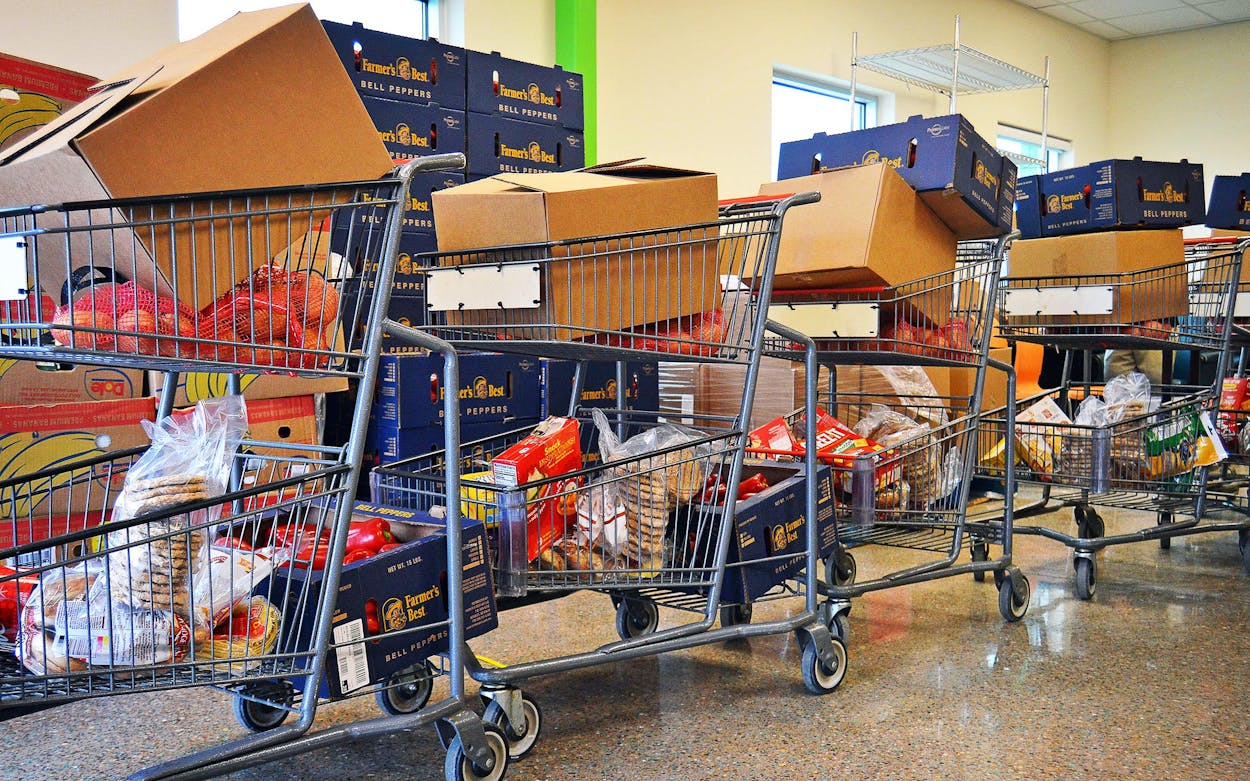Laid-off waitresses, bartenders, and truck drivers. Oil workers, welders, elementary school kids, and the entire staff of a traveling carnival. These are just a few of the Texans in the 150 to 350 cars that line up around the parking lot of the West Texas Food Bank in Odessa on any given day. Most have never had to get food assistance before—in April, 74 percent were first-timers, says Libby Campbell, the food bank’s executive director.
“This isn’t generational poverty,” Campbell says of those in the long lines. “These are people who lost their jobs overnight.” She’s recognized more than one former food bank volunteer among those seeking help.
Similar scenes are playing out at food banks that serve primarily rural areas across Texas. They may not draw the massive lines seen in viral photos from their big-city counterparts, but rural food banks face their own distinct challenges during the pandemic and economic downturn. They all serve areas that were already among Texas’s 58 food deserts—counties that lack a single large grocery store—before the pandemic began. Smaller food banks also pay more to feed each person than their larger urban counterparts do. Meanwhile, donations are dropping as individuals and businesses tighten budgets. And food banks have struggled to find enough staff and volunteers to safely meet the surge in demand during the pandemic. Add it all together, and you’ve got what Celia Cole, CEO of Feeding Texas, calls “a perfect storm.”
“This has been different than other disasters like Hurricane Harvey, when people opened their pocketbooks and pantries to help,” says Cole, whose organization oversees a network of 21 Texas food banks. In addition to an immediate drop in donations, Texas food banks lost 75 percent of their volunteers, she says. “Food, funds, volunteers: those have all declined across the state, but most acutely in rural areas.”
First, there’s the issue of food itself. Food banks get most of their supply from grocery stores, purchased in bulk at a discount. But grocery stores now have their own supply chain issues, so they have less to sell to food banks. Meanwhile, transportation prices have gone up for everyone—a change that has hit organizations serving rural areas especially hard, since they must ship food farther. Kara Nickens, CEO of the Wichita Falls Area Food Bank in North Texas, is scrambling to figure out the complex logistics. Her food bank pays a higher cost per pound than, say, the Houston Food Bank would, because she’s ordering a much smaller volume. Meanwhile, freight costs have increased by 50 percent, and demand has nearly doubled, she says.
“We are a small food bank, so whereas the larger food banks can order a truck of a particular item, we need more mixed loads because our warehouse is smaller,” she says. “Due to the food shortage, a lot of suppliers are only offering straight orders, so we’re working with other food banks to get those mixed loads.”
If getting the food to the food banks isn’t challenging enough, getting it out to hungry people has been even harder. Food banks don’t normally distribute much food directly from their warehouses, instead sending it to smaller food pantries at places like churches, nonprofits, and senior centers. But when the pandemic began, many of those pantries shut down, Cole explains. So food banks switched to direct distribution, rejiggering their business models entirely. In Wichita Falls, Nickens’s scrappy staff of 22 improvised new solutions, including mobile delivery in far-flung towns like Electra and Throckmorton, neither of which has a large grocery store for miles around.
Funds are also a looming problem, particularly as donations dry up. Relief money from the U.S. Department of Agriculture, the Texas Division of Emergency Management, and the Paycheck Protection Program (PPP) has provided some initial relief, but food bank leaders aren’t sure how they’ll balance budgets long-term.
“We have had our local funders pour out their checkbooks to support us, but I am deeply concerned about what’s going to happen when the PPP ends in July,” says Campbell, in West Texas. “And with unemployment benefits running out later this summer or early fall, I think we will have two more large spikes in need.”
Cole, with Feeding Texas, says relief funds will tide food banks over for now, but the long-term financial picture is still murky. “Given that we have some resources coming in now, we’re still concerned, because the demand is not abating,” she says. “Food banks are very nimble in a way that I think government typically isn’t. But we aren’t able to make up for the loss of food and funds without significant government intervention.”
Compounding the problem, for some rural food banks, is the new need for paid, and not volunteer, staffing. Some food banks shut down their volunteer programs when the pandemic began, fearing that their volunteers—many of whom are elderly—could catch the virus or infect others. Overall, Texas’s food bank volunteer workforce shrank by 75 percent, Cole says. But then “some of them had to make up for the loss of volunteers by hiring paid staff,” Cole explains. As a result, “lots of our smaller food banks are concerned about operating expenses.”
Eight of the hardest-hit food banks have gotten some help from Texas Army National Guard soldiers, who pack boxes of food and load them into cars at drive-through distributions. Staff at the West Texas Food Bank are thankful for them, as they’re among the handful of rural food banks that made the difficult choice to close volunteer programs entirely out of coronavirus fears.
“We knew as a rural area, we’d have less access to testing and that would put us at risk of having an outbreak in our facility,” says Campbell. “To get from our main warehouse in Odessa to Presidio is a one-way, three-hour drive. We can’t have our staff become ill. So we made the decision to have zero volunteers.” Still, her staff of 48 is on track to distribute 900,000 pounds of food this month, up from 575,000 before the pandemic.
Stuart Haniff, CEO of the Food Bank of the Rio Grande Valley in Pharr, also shut down his institution’s volunteer program, which relied on the assistance of hundreds. He says that nonetheless his staff of 74 is serving far more hungry people (roughly 95,000 per week, versus 64,000 pre-pandemic) at a higher cost ($50,000 per month, up from $10,000 per month, to operate drive-through emergency pantries).
“Nobody has been turned away, everyone has been fed,” says Haniff, who started his job just six months ago—“but it feels like 28 years in COVID time,” he notes wryly. He points out that the public’s idea of frontline pandemic workers—doctors, nurses, delivery drivers—doesn’t usually include food pantry staff. “But we have a whole army feeding our neighbors,” he says. “We’re first responders for food.”








